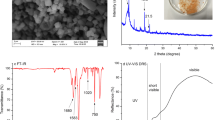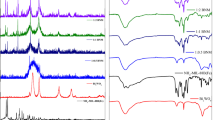Abstract
A straightforward photodegradation procedure was developed using a new photocatalyst under visible light to degrade diazinon and fenitrothion in water samples. For this purpose, a novel photocatalyst based on MOF on MOF composite (MIL-100 (Fe)@biometalic MIL-53 (Fe, Ni)) was synthesized by a simple and efficient hydrothermal strategy in two steps. The ability of the prepared photocatalyst for the diazinon and fenitrothion photodegradation was compared with its components (MIL-100 (Fe) and biometalic MIL-53 (Fe, Ni)) under the same conditions. The photocatalyst shows the highest degradation efficiency toward diazinon and fenitrothion. The Box-Behnken design was selected as a suitable experimental design for optimizing the effective parameters on the degradation procedure. The optimum pH, diazinon and fenitrothion concentration, photocatalyst amount, and H2O2 volume for the degradation method were 3.8, 26 mg L−1, 76 mg and 0.74 mL. The kinetics of diazinon and fenitrothion photodegradation using MIL-100 (Fe)@biometalic MIL-53 (Fe, Ni) as the photocatalyst was also evaluated by a pseudo-first order model. The rate constant and half-life of the model for diazinon and fenitrothion photodegradation were 0.0311 and 0.0291 min−1, and 22.28 and 23.90 min. The investigation of the photocatalyst reusability indicated that it can apply for the diazinon and fenitrothion photodegradation for five degradation cycles without significant change in its ability.




Similar content being viewed by others
Data availability
All data generated or analysed during this study are included in this published article [and its supplementary information files].
References
Sun S, Sidhu V, Rong Y, Zheng Y (2018) Pesticide pollution in agricultural soils and sustainable remediation methods: a review. Curr Pollut Rep 4:240–250
Sahin C, Karpuzcu ME (2020) Mitigation of organophosphate pesticide pollution in agricultural watersheds. Sci Total Environ 710:136261
Sanchez-Hernandez JC, Del Pino JN, Capowiez Y, Mazzia C, Rault M (2018) Soil enzyme dynamics in chlorpyrifos-treated soils under the influence of earthworms. Sci Total Environ 612:1407–1416
Kaushal J, Khatri M, Arya SK (2020) A treatise on organophosphate pesticide pollution: current strategies and advancements in their environmental degradation and elimination. Ecotoxicol Environ Saf 207:111483
Slotkin TA, Skavicus S, Ko A, Levin ED, Seidler FJ (2019) Perinatal diazinon exposure compromises the development of acetylcholine and serotonin systems. Toxicology 424:152240
Ohbe H, Jo T, Matsui H, Fushimi K, Yasunaga H (2018) Cholinergic crisis caused by cholinesterase inhibitors: a retrospective nationwide database study. J Med Toxicol 14:237–241
Sulaiman NS, Rovina K, Joseph VM (2019) Classification, extraction and current analytical approaches for detection of pesticides in various food products. J Consum Prot Food Saf 14:1–13
Ghorbani M, Mohammadi P, Keshavarzi M, Saghi MH, Mohammadi M, Shams A, Aghamohammadhasan M (2021) Simultaneous determination of organophosphorus pesticides residues in vegetable, fruit juice, and milk samples with magnetic dispersive micro solid-phase extraction and chromatographic method; Recruitment of simplex lattice mixture design for optimization of novel sorbent composites. Anal Chim Acta 2021:338802
Sapbamrer R, Hongsibsong S (2019) Effects of prenatal and postnatal exposure to organophosphate pesticides on child neurodevelopment in different age groups: a systematic review. Environ Sci Pollut Res 26:18267–18290
Mohammadi P, Ghorbani M, Mohammadi P, Keshavarzi M, Rastegar A, Aghamohammadhassan M, Saghafi A (2021) Dispersive micro solid-phase extraction with gas chromatography for determination of Diazinon and Ethion residues in biological, vegetables and cereal grain samples, employing D-optimal mixture design. Microchem J 160:105680
Iwuozor K, Emenike E, Gbadamosi F, Ighalo J, Umenweke G, Iwuchukwu F, Nwakire C, Igwegbe C (2022) Adsorption of organophosphate pesticides from aqueous solution: a review of recent advances. Int J Environ Sci Technol 2022:1–50
Yang C, Wang J, Yan W, Xia Y (2022) Facile synthesis disposable MOF membrane filter: growth of NH2-MIL-125 (Ti) on filter paper for fast removal of organophosphorus pesticides in aqueous solution and vegetables. Food Chem 389:133056
Zheng W, Sun Y, Gu Y (2023) Synergism of adsorption and ROS-dominated catalytic oxidation in activating peroxymonosulfate by magnetic hybrid MOFs for selective removal of organophosphorus pesticides. Chem Eng J 459:141668
Dash DM, Osborne WJ (2022) A systematic review on the implementation of advanced and evolutionary biotechnological tools for efficient bioremediation of organophosphorus pesticides. Chemosphere 2022:137506
Ghorbani M, Shams A, Seyedin O, Afshar Lahoori N (2017) Magnetic ethylene diamine-functionalized graphene oxide as novel sorbent for removal of lead and cadmium ions from wastewater samples. Environ Sci Pollut Res 25:5655–5667
An X, Chen Y, Ao M, Jin Y, Zhan L, Yu B, Wu Z, Jiang P (2022) Sequential photocatalytic degradation of organophosphorus pesticides and recovery of orthophosphate by biochar/α-Fe2O3/MgO composite: a new enhanced strategy for reducing the impacts of organophosphorus from wastewater. Chem Eng J 435:135087
Ren G, Han H, Wang Y, Liu S, Zhao J, Meng X, Li Z (2021) Recent advances of photocatalytic application in water treatment: a review. Nanomaterials 11:1804
Mohammadi P, Ghorbani M, Keshavarzi M, Rastegar A, Pakseresht M, Mohammadi M (2022) Dispersive micro solid-phase extraction as a green procedure for extracting prostate anti-cancer drugs in real water and biological samples and optimization of sorbent composite with an optimal mixture design. Int J Environ Anal Chem. https://doi.org/10.1080/03067319.2022.2045588
Keshavarzi M, Ghorbani M, Mohammadi P, Pakseresht M, Ziroohi A, Rastegar A (2022) Development of a magnetic sorbent based on synthesis of MOF-on-MOF composite for dispersive solid-phase microextraction of five phthalate esters in bottled water and fruit juice samples. Microchem J 182:107934
Saghafi A, Ghorbani M, Pakseresht M, Shams A (2022) Synthesis and development of novel magnetic polymeric sorbent to simultaneous extraction of three anti-cancers using dispersive micro solid phase extraction procedure in biological and water samples. Microchem J 183:108047
Gordi Z, Ghorbani M, Ahmadian Khakhiyani M (2020) Adsorptive removal of enrofloxacin with magnetic functionalized graphene oxide@ Metal-organic frameworks employing D-optimal mixture design. Water Environ Res 92:1935–1947
Cheng W, Tang X, Zhang Y, Wu D, Yang W (2021) Applications of metal-organic framework (MOF)-based sensors for food safety: enhancing mechanisms and recent advances. Trends Food Sci Technol 112:268–282
Mallakpour S, Nikkhoo E, Hussain CM (2022) Application of MOF materials as drug delivery systems for cancer therapy and dermal treatment. Coord Chem Rev 451:214262
Zhao X, Li J, Li X, Huo P, Shi W (2021) Design of metal-organic frameworks (MOFs)-based photocatalyst for solar fuel production and photo-degradation of pollutants. Chin J Catal 42:872–903
Russo V, Hmoudah M, Broccoli F, Iesce MR, Jung OS, Di Serio M (2020) Applications of metal organic frameworks in wastewater treatment: a review on adsorption and photodegradation. Frontiers in Chemical Engineering 2:581487
Ahmadi M, Ayyoubzadeh SM, Ghorbani-Bidkorbeh F, Shahhosseini S, Dadashzadeh S, Asadian E, Mosayebnia M, Siavashy S (2021) An investigation of affecting factors on MOF characteristics for biomedical applications: a systematic review. Heliyon 7:e06914
Chai L, Pan J, Hu Y, Qian J, Hong M (2021) Rational design and growth of MOF-on-MOF heterostructures. Small 17:2100607
Hong DH, Shim HS, Ha J, Moon HR (2021) MOF-on-MOF architectures: applications in separation, catalysis, and sensing. Bull Korean Chem Soc 42:956–969
Abdpour S, Kowsari E, Moghaddam MRA (2018) Synthesis of MIL-100 (Fe)@ MIL-53 (Fe) as a novel hybrid photocatalyst and evaluation photocatalytic and photoelectrochemical performance under visible light irradiation. J Solid State Chem 262:172–180
Tian H, Araya T, Li R, Fang Y, Huang Y (2019) Removal of MC-LR using the stable and efficient MIL-100/MIL-53 (Fe) photocatalyst: the effect of coordinate immobilized layers. Appl Catal B 254:371–379
Lente G (2018) Facts and alternative facts in chemical kinetics: remarks about the kinetic use of activities, termolecular processes, and linearization techniques. Curr Opin Chem Eng 21:76–83
Acknowledgements
The authors would like to thank Payame Noor University, Tehran, Iran, for financial support.
Author information
Authors and Affiliations
Contributions
AB: Formal analysis, Validation, Data curation, Writing e original draft, Resources. ZG: Conceptualization, Methodology, Supervision, Writing e review & editing, Investigation, Resources.
Corresponding author
Ethics declarations
Conflict of interest
The authors declare they have no financial interests.
Ethical approval
This article does not contain any studies with human or animal subjects.
Additional information
Publisher's Note
Springer Nature remains neutral with regard to jurisdictional claims in published maps and institutional affiliations.
Supplementary Information
Below is the link to the electronic supplementary material.
Rights and permissions
Springer Nature or its licensor (e.g. a society or other partner) holds exclusive rights to this article under a publishing agreement with the author(s) or other rightsholder(s); author self-archiving of the accepted manuscript version of this article is solely governed by the terms of such publishing agreement and applicable law.
About this article
Cite this article
Gordi, Z., Bayat, A. Development and synthesis of a metal–organic framework on metal–organic framework composite as a novel catalyst for photodegradation of two organophosphorus pesticides under visible light. Reac Kinet Mech Cat 136, 1673–1688 (2023). https://doi.org/10.1007/s11144-023-02422-y
Received:
Accepted:
Published:
Issue Date:
DOI: https://doi.org/10.1007/s11144-023-02422-y




